Белоградчишки скали
Belogradchik Rocks
Useful Information
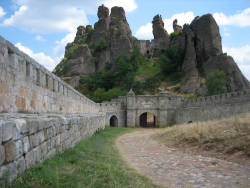
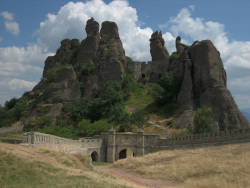
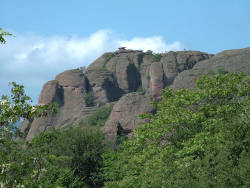
| Location: |
Belogradchik.
(43.623763, 22.676814) |
| Open: |
no restrictions. Museum of History: All year daily 8-12, 13-17. Belogradchik fortress: APR daily 9-18. MAY daily 9-19. JUN to AUG daily 9-20. SEP daily 9-19. OCT daily 9-18. NOV to MAR daily 9-17. [2021] |
| Fee: |
free. Museum of History: Adults BGN 3, Children (-18) BGN 2. Belogradchik fortress: Adults BGN 6, Children (-18) BGN 4, Students BGN 4, Seniors BGN 4, Families (2+*) BGN 12. Combined ticket Belogradchik fortress + Magura cave + Museum of History + Department "Nature" + Art Gallery: Adults BGN 22. [2021] |
| Classification: |
 Gorge Gorge
|
| Light: | n/a |
| Dimension: | |
| Guided tours: | self guided |
| Photography: | allowed |
| Accessibility: | no |
| Bibliography: | |
| Address: |
Исторически музей Белоградчик, Белоградчик, ул. Цоло Тодоров 1, ул. Княз Борис I. 3900.
Belogradchik History Museum, 3900 Belogradchik, 1 “Kapitan Krastyo” Str., Tel: +359-936-5-3469. E-mail: Крепост Белоградчик, Belogradchik Fortress, Пор. Чолаков 23, 3900 Белоградчик, Tel: +359-936-5-3022. |
| As far as we know this information was accurate when it was published (see years in brackets), but may have changed since then. Please check rates and details directly with the companies in question if you need more recent info. |
|
History
Description
“Neither the gorges of Ollioules in Provence, nor the Pincarbo ravine in Spain, nor the Alps, nor the Pyrenees, nor the marvelous mountains of Tirol in Switzerland possess something that could be compared to the views I saw in Bulgaria at Belogradchik”
Jerome Blanqui, 1841
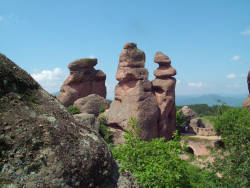
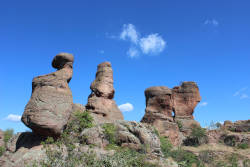
Belogradchik Rocks is a conglomerate formation which consists of rocks, pinnacles, gorges and small caves. The limestone conglomerate rocks are subject to weathering, which works mostly on the cracks in the rock widening them and separating the blocks with narrow gorges. Depending on the resistance of the rock and the intensity of weathering there are parts where huge rocks have narrow cracks, cracks which are widened to form gorges, and single standing pillars where the surrounding rocks have already been eroded. The area is very popular among climbers. The main area of rocks is located south of the town Belogradchik, after which the rocks are named. There are numerous trails through the rocks and you can walk there without any restrictions. Don’t leave the trails though, the area is protected.
There are numerous points from which you can access the rocks, the best are the Fortress and the History Museum. The fortress Крепост Белоградчик (Kaleto Belogradchik, Belogradchik Fortress) was built into the rocks. The site is a quite spectacular, a ruined castle with a great view on the most impressive rock formations. The fortress is 610 m asl and at a strategic position between the Balkan passages “Sveti Nikola” and “Kadu-Boaz”. The first fortress of Roman origin existed at the site between the 1st and 3rd century. It was extended in the 14th century and captured by the Ottomans and partially destroyed. They made only minor repairs. Reconstruction and enlargement has been started in 1805 by French engineers and was completed by Italian fortification experts in 1837. During the Russian-Turkish Liberation War (1877–1878) it was besieged by Russian and Romanian troops.
The Исторически музей Белоградчик (Belogradchik History Museum) is also a very good starting point. It has a huge parking lot and many trails through the rocks start here. The museum is also quite interesting, as it offers a wealth of background info on the town, the rocks, the fortress and even nearby Magura cave.
The limestone conglomerate and sandstone which is responsible for the formation of the rocks has an outcrop which is 3 km wide and 30 km long. At some places the rock formations reach some 200 m in height. Many of the more spectacular rocks were named, in general with a story which explains the name. Here are some, so you get an impression: Adam and Eve, Shepherd Boy, Dervish, First Slabstone, Camel, Mushrooms, Cuckoo, Red Wall, Mental Stone, Rebel Velko, and Pine Stone.
A beautiful nun fell in love with a man on a white horse and got pregnant. As a result she was cast out by the monks but at the moment when she was leaving the nunnery, day turned to night and all, the nun, the monks, and the man on the white horse were turned to stone. The rocks are now called Madonna, Horseman, and Monks.
Vita was born at Mount Midzhur, she had golden blond hair, deep blue eyes, scarlet lips, slender as a poplar, and she was a good singer. As she grazed goats on the mountain slopes, her singing resounded and enchanted all living things. One day she met a shepherd named Luca who played the flute unsurpassed and great love was born in her heart. Once an old monk came to her parents and, astonished by her beauty, he convinced her parents to send her to the monastery, for fear that so much beauty was dangerous. There were two monasteries on the two highest peaks of the Belogradchik rocks, one for nuns and one for monks. The abbess renamed her Sister Bithynia and tried to persuade her for a long time. But the young novice was lonely and cried inconsolably in her dark cell. Then she began to threaten her with "God’s punishment" if she did not accept monasticism. On the feast of the Annunciation, Vita, in her cell, heard a flute. She followed the flute and found her lover in the barn. But the old abbess came running, and dragged Vita to her cell and locked her in. But one night Vita heard the sad distant voice of a flute. The shepherd Luca had become a novice in the monk monastery, and secret meetings between the two lovers began. Vita came to life and the nuns thought that she had come to terms with her fate, but after a year Bithynia locked herself in her cell again and did not leave. The abbess, furious with rage, threatened to drive away the prostitute, to punish her cruelly, and to burn her child. The elders of both monasteries gathered and decided to expel the novice Bithynia from the convent with her child. At this time it was a great shame to be expelled from a monastery, and she faced to live like lepers in a cave or forest, amd it was still winter. She asked for mercy for her child, but the nuns were relentless and drove her out with a curse. But then the earth shook and the nuns’ monastery collapsed with a roar, burying everything alive inside. The monks tried to flee, but Vita with her child, Luca, and the monks were petrified.
Once a beautiful schoolgirl fell in love with a blacksmith. When her mean schoolmaster heard about this he chased her. While she was fleeing from him, she ran into a bear, when all were turned to stone. The rocks are now called the Schoolgirl, Bear, and Schoolmaster,
As the rock is limestone it is also karstified and there are hundreds of karst caves in the area. Nearby Magura Cave is located in the same formation. Some think the rocks were used as observatories by the prehistoric inhabitants, to learn about the stars and the circles of the universe. Then they went to the Magura Cave to paint what they had learned.

 Search DuckDuckGo for "Belogradchik Rocks"
Search DuckDuckGo for "Belogradchik Rocks" Google Earth Placemark
Google Earth Placemark Крепост Белоградчик
Крепост Белоградчик  (visited: 15-AUG-2021)
(visited: 15-AUG-2021) Belogradchik Rocks - Atlas Obscura (visited: 15-AUG-2021)
Belogradchik Rocks - Atlas Obscura (visited: 15-AUG-2021) Index
Index Topics
Topics Hierarchical
Hierarchical Countries
Countries Maps
Maps